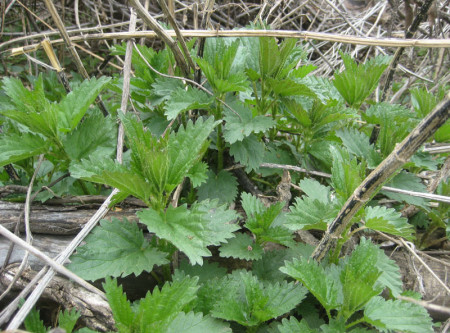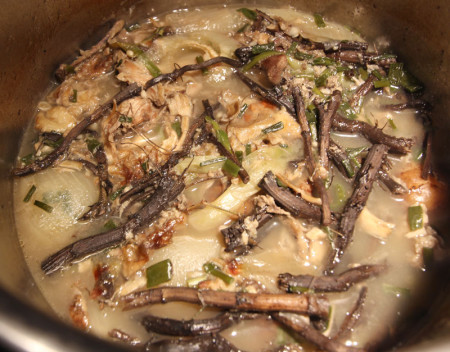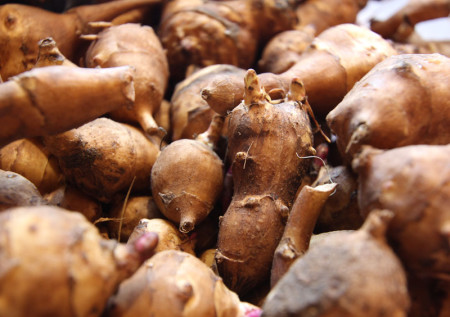
My friend’s husband tells tales of growing up in northern Wisconsin next to the Menominee Nation, where as a boy he played with the kids on the reservation. When they got hungry, they’d head to whichever family’s house was hosting that week’s “bouyah,” a Midwestern tradition believed to be of Belgian origin, which in the Menominee households involved an ongoing pot of soup to which new ingredients were added as they were hunted and foraged.
I imagined myself making such a soup the other day as I tossed whatever fresh and dry ingredients I could find into a big pot at the crack of dawn, my first opportunity to play with wild food again after a protracted grand finale to my snowboard-work season that involved great excitement and disappointment when I tried out for a regional team of top instructors.
I didn’t make the team but I figure I had a decent showing regardless—how many 40-year-old women do you know who hit 35-foot kickers? Beforehand, I worked relentlessly on my 360’s, which is probably why I’m so exhausted. (Linked is my “chicken wing backside 360.”)


In any case, I normally I wear my stress on my sleeve but this time I must have been holding it in because, I swear, less than 30 minutes after I left the team announcement my glands swelled up to fill my throat and my whole head succumbed to a cloud of phlegmy congestion.
A Complex Wild Broth
The early morning cookery was a two-pronged effort, then—a soup to combat my nasty cold, and a much-needed spring cleaning of found and purchased ingredients. Here’s what went into it:
- Stinging nettle pot likker (Urtica sp.) – First I simmered the bones, skin, and fat saved from a maple-smoked chicken in stinging nettle “pot likker”—a term that refers to the colored cooking water leftover from steaming or boiling greens. We’d eaten the steamed nettles—which came from a wild shopping trip in the Denver area with my friend Butter last week—on a previous night, and I’d saved the pot likker in a jar in the refrigerator.
- Canada thistle “roots” (Cirsium arvense) – Mostly because they were taking up space on top of the cabinet in the living room, I added a whole mess of dried Canada thistle “roots.” These are not really roots at all, but the underground portion of stems. I’d ripped a ton of this edible invasive species from my yard last fall and dried the woody underground bits for this purpose. At this stage they are too tough for outright eating, but impart an artichoke-like flavor to teas and broths.
- Alliums – My onion choices included one overgrown store-bought brown onion with attached greens, dried chives, and some finely chopped fresh wild onion greens and dried wild onion bulblets—both from different seasons of the bulbil onion (Allium rubrum) that grows near Butter’s house in the Denver area.
- Porcini broth (Boletus edulis) – As it turns out, I am not the only broth squirrel in the house, because I also discovered a jar of porcini broth leftover from when Gregg got into my dried mushrooms and reconstituted a ton of them to make a well-endowed pizza. I splashed a bit of the mushroom broth into the soup, but not too much, so as to preserve the other flavors.
- Salt & pepper
Fabulous Fartichokes
Normally I use potatoes for the starch in my soups, but this time I had in my possession a generous bag of jerusalem-artichokes, the underground, edible tubers of the sunflower Helianthus tuberosus. This native North American species is called “jerusalem-artichoke,” foraging author Sam Thayer explains in Nature’s Garden (2010), not for any Jerusalem-related reason at all, but probably due to a corruption of the Spanish or Italian word for sunflower, “girasol.”

There are wild, native jerusalem-artichokes and there are cultivated varieties of the same species. Mine, again, came from Butter, who has taken to growing them in her front-yard garden.
Thayer writes how he cultivated jerusalem-artichokes before ever finding them in the wild; the practice made it easier to recognize wild and feral populations later. Consumed under-ripe, both wild and cultivated varieties can cause “horrendous gas,” he notes, but that of the wild variety is often worse. Long-cooking, from 1 to 6 hours, can help to allay the problem, with fall and winter-harvested tubers requiring a longer cook time than those harvested in spring.
“Wait, did you get those in the farty season or the non-farty season?” Gregg asked.
“I guess you’ll have to wait and see,” I replied.
For this soup I threw a handful of whole, spring-harvested, hopefully non-farty jerusalem-artichokes into the pot at the very start of cooking, so that in the end I think they cooked for 3 hours. I pulled them out when I strained the non-edible stuff from the broth, chopped them into cubes and tossed them back into the cleaned broth with sliced carrots, more fresh-snipped wild onion greens, and chicken bits.
Oh man, I cannot understate how yummy jerusalem-artichokes are in soup! And I’m pleased to say we have no excessive flatulence to report.
Soup to Herald Winter’s Return
I’m happy to have this mini-bouyah soup on the stovetop now—not only for my battered, beaten, cold-stricken body, but also because winter decided to return with a vengeance. After more than a month of unseasonably warm weather that saw plants popping up outside my window, taunting me as I headed to work at the mountain each day, a thick and unrelenting spring storm now blankets the landscape, obscuring my plant friends underneath. So I guess I will sit here, eat soup by the fire, and heal up as I await spring once more.

Love the idea of bouyah. And how can you resist something that is so much fun to say? Your soup sounds absolutely soul-satisfying.